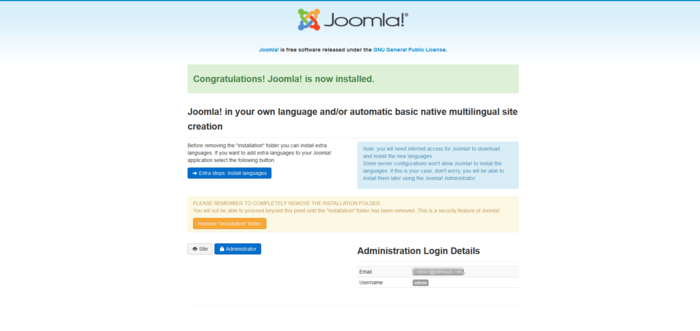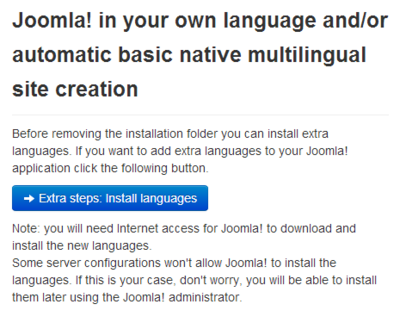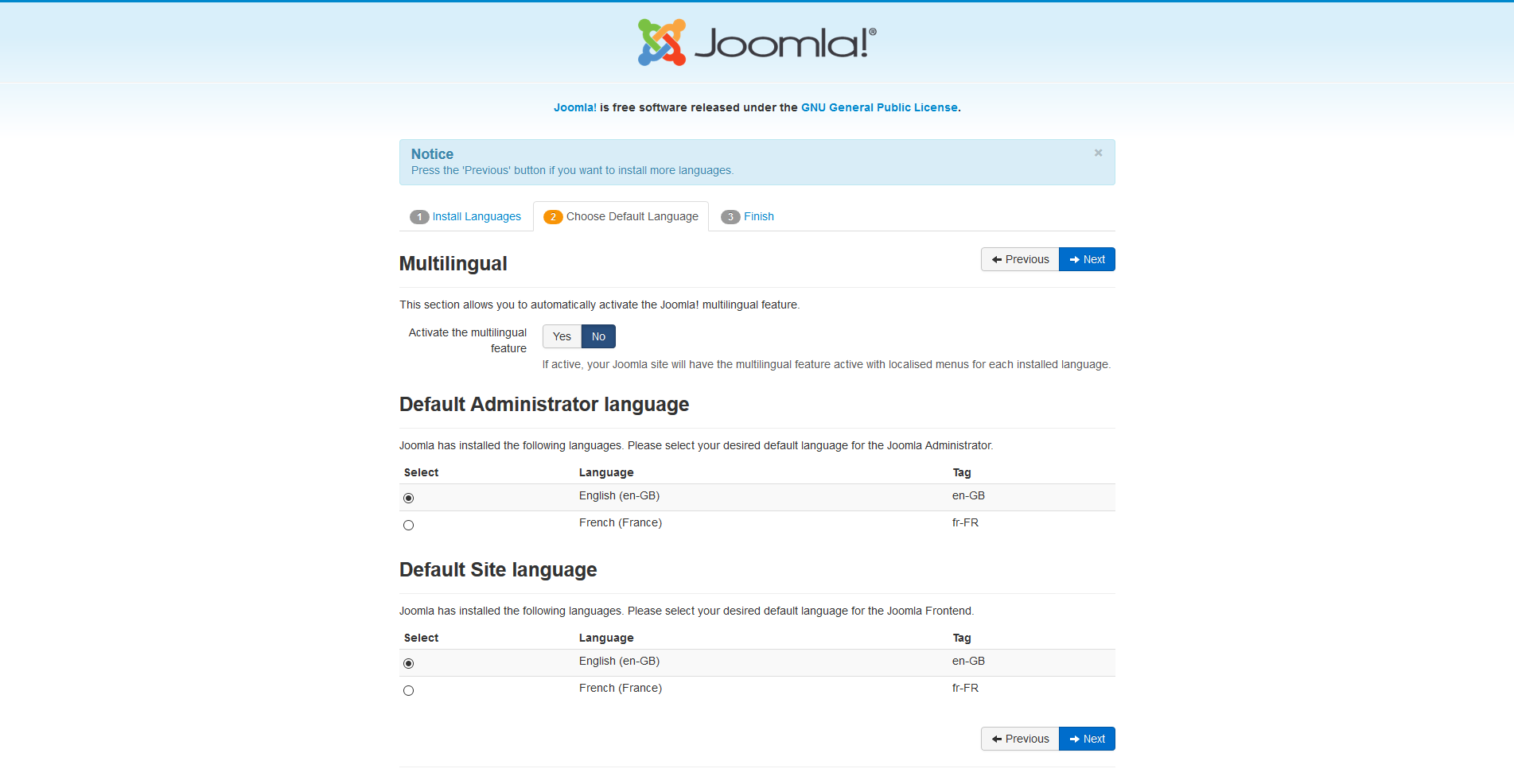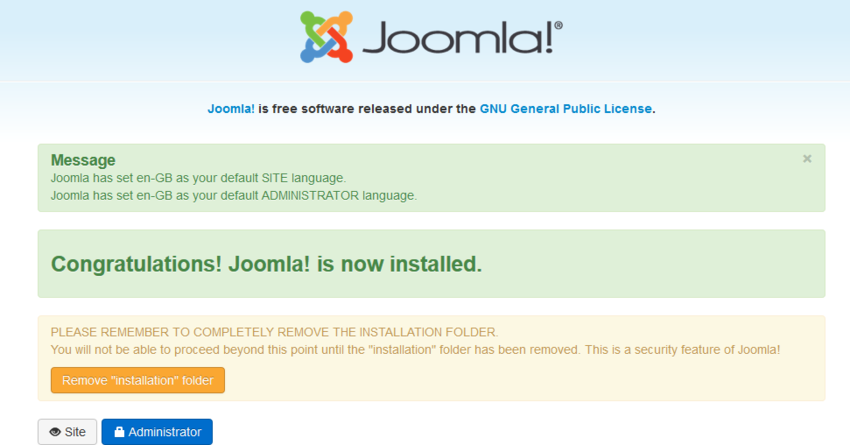安装Joomla!3
From Joomla! Documentation
首先,安装Joomla!非常简单. Joomla!内置的Web安装向导指导你几步完成安装。
配置要求
主机要求
我们开始安装Joomla!之前, 有几个先决条件需要满足才能顺利完成安装Joomla ! 3.x. 你可能是租用了虚拟主机,或是vps服务器(包括国内阿里云服务器),也有可能是你自己的本地环境进行搭建。检查这些软件环境是否满足安装需要。(如有问题可以与六艺Joomla人员联系)
你需要下面的环境配置才能安装并使用Joomla!
引用
推荐 PHP.ini 设置
有几个 PHP 设置项目需要为Joomla配置好。这项配置项目需要修改“php.ini"或r "user.ini".如果你不了解,可以咨询你的服务器服务商获取技术支持。如果你在本地主机上面配置网站环境,比如 XAMPP, (六艺推荐您安装PHPstudy)你可能需要自行设置。
PHP.ini 如下显示值
- memory_limit - 最小: 64M 推荐: 128M 或更高
- upload_max_filesize - 最小: 20M
- post_max_size - 最小: 20M
- max_execution_time: 至少 120 推荐: 300
安装准备
开始前,你需要先两步来做准备工作:下载Joomla安装文件,然后分配一个Mysql数据给接下来的joomla使用。
下载或升级Joomla!文件包
- 下载当前最新版 Joomla! 3.x
- 将下载的安装包上传到服务器上.可以使用 FTP 客户端软件 去上传Joomla! 3.x 文件. 其他上传软件还包括 FTP 客户端列表.请选择一个你习惯的软件即可。
- 提示—这可以通过简单的下载包(一般为一个zip文件)将其转移到您的服务器,然后将其解压缩, 无论采取什么方式,重要的是你要将其放在正确的位置(比如服务器的html/下面 或www/下面,具体请咨询你的服务器提供商)
根目录 "root"是指你的服务器上用来存放网站的主目录。一般是public_html 或 htdocs文件夹命名.
你可以将下载的Joomla安装包上传到主机的根目录中。并运行解压缩,将你的Joomla压缩包中的文件释放出来。
如果你解压缩,请确保加压缩后的文件夹及文件存放在html/或www/下面,而不是又嵌套一层文件夹,类似于这样: Joomla 然后上传文件夹,你的网站将会在访问 yoursitename.com/Joomla 而不是 yoursitename.com.
为Joomla安装准备数据库
- 如果你不知道如何创建一个数据库,首先请阅读"为Joomla创建一个数据库" 或跳到第#2.步
- 填写你的数据库信息。(六艺提示:1如果你输入的数据库信息错误,会收到错误提示“无法连接到数据库”。如果你使用root用户进行操作,可以不用提前创建数据库,在安装过程中会自动创建)
- 数据库的位置, 本地填写localhost 或者远程数据库服务器
dbserver1.yourhost.com?根据你的运营商提供的数据信息填写 - 数据库名称
- 用户名
- 数据库密码
- 数据库的位置, 本地填写localhost 或者远程数据库服务器
开始安装
主要配置
准备安装Joomla !。通过浏览器打开你刚刚设定的的主机网址,启动Joomla !安装程序,主机安装使用 http://www.yoursitename.com. 如果你在本地电脑上面安装Joomla!你将使用 http://localhost/<Joomla文件路径>, 你应该看到安装向导界面.
Joomla!将自动判断你的计算机语言,你也可以通过 Select Language选择安装的语言。
填写以下信息
- Site Name: 为你的网站起一个响亮的名字(当然以后可以修改)Site Global Configuration .
- Description: 输入网站说明. 这是一个“全局设置”述用于每个页面,主要是用户SEO的meta标签部分。一般来说,40字以内比较合适。可以空着,安装以后可以在站点全局设置 页面进行修改. 更多Meta设置说明可访问全局meta设置 和 搜索引擎 meta-data.
- Admin Email Address: 网站管理员邮箱. 输入一个有效的电子邮件,当你忘记你的密码可以帮你找回密码。
- Admin Username: Joomla! 3之前版本默认 "admin"作为超级管理员用户 (为了网站安全,六艺建议你设置其他用户名作为超级用户,而不使用admin) (选择一个好的安全措施) 或使用My Profile 在 Administration 界面去修改它.
- Admin Password: 为你的超级管理员账户设定密码 (frontend & backend), 虽然没有强制要求密码复杂程度,六艺建议尽量使用复杂一些的密码. 稍后可以在My Profile Administration 界面去重新设置它. 再次确认一遍你的密码 Confirm Admin Password
- Site Offline: 如果你设置了此项,当打开网站前台时会提示“网站关闭”状态,作为管理员可通过密码正常访问前台页面。(不建议初学者设定offline)
yoursitename.com去访问前台首页yoursitename.com去显示前台首页. 你在任何时间使用Site Global Configuration 管理后台界面去设置改变这种设置
当每项都填写后,点击“下一步”按钮继续
数据配置
配置设置
你需要为将要安装的joomla输入一些数据信息. 如下面的 "准备安装" 页面. 你也可以阅读 为Joomla!创建数据库.
很简单的步骤,下面提供给您做参考 MySQLi 数据库. 安装页面给出了一些说明解释,
- 数据库类型: MySQLi是推荐的类型
- Hostname 你的数据是在一台服务器上面吗?如果是则选择
localhost, 有些数据库可能是在远程其他主机上面(具体要咨询一下你的主机服务商)dbserver1.yourhost.com - Username: 数据库用户名
- Password: 数据库密码
- Database Name: 数据库名称
- Table Prefix: 表前缀,默认系统分配了表前缀,例如,
jos3_你可以使用默认. 你也可以设置个性化的前缀,这个无关紧要,但是别忘了输入下划线 (_) 基于这个前缀 - 这里给你两个选择,如果老的数据库:中如果已经有数据表存在了,是备份还是直接清空删除。 由你在这里进行选择。
所有的选择在以后的使用过程中可以进行重新编辑。 网站通用配置 页面,有这项选项的修改位置。
当填写完所有信息后,点击”下一步“按钮
Finalise
Overview
It is now time to finalise the Joomla! installation. The last page of the web browser installation contains all the information about the installation. This includes the options(at the top) for installing sample data and the installation's configurations(at the bottom).
Install Sample Data and Email Configurations
The first options are for automatically installing sample content to the website and emailing the configuration settings.
If you are new to Joomla! it would be beneficial to install some sample data to see how Joomla! works. You can at this time choose to have the configuration settings emailed to you. If the Email Configuration choice is selected, the Email Password choice will appear. The email password is off by default for security. You can choose to have the password included, just click Yes.
Time to check the configurations of your install and the environment of the installation.
Configuration Check
Checking Your Configurations
If everything is in order, you will see the install at the top of the overview page. If not, this is the place to check and see what may be causing an issue.
The section is broken into 4 groups:
- Main Configuration: all the website specific information, such as the website name, description, admin username, etc.
- Database Configuration: contains the information about the database Joomla! will use.
- Pre-Installation Check: these requirements must all be shown as Yes, otherwise you will not be able to install Joomla! With the exception of the PHP Version, the rest are usually controlled in the php.ini. You may need assistance from your host in correcting these settings or checking to see if it is possible to adjust them.
- Typical PHP settings that might cause the install to fail and may need adjusting include the following with suggested values: (1) memory_limit (64M), (2)max_execution_time (30), (3) post_max_size (30M), (4) upload_max_filesize (30M). For more information, see PHP configuration file file.
- Recommended Settings: these are settings are recommended in your PHP configuration, but will not prevent Joomla! from being installed. You can refer to the above instructions on how they may be changed.
If everything is correct and all checks are passed, you may now click the Install button in the top right corner of the Overview page. This will start the actual installation process.
After you click the Install button, you should see a progress bar with additional information of the installation. Once the installation completes, you should see the success page!
Finishing Up
Success and Finishing Up the Installation
Congratulations! Joomla! 3 is now installed. If you want to start using Joomla! right way without installing extra languages there is one last step to complete the installation. You must delete the Installation Folder. Click on Remove Installation folder and a success message will appear. Now you can navigate to the Administrator log in by clicking Administrator or go right to your site by clicking Site.
Installing Extra Languages
Before you complete your installation by deleting the Installation Folder, click on:
- → Extra steps: Install languages
This will continue the installation of Joomla! by taking you to a new installation page.
Install Languages
A list of language packs is displayed.
Check the language or language packs you wish to install. Remember the following:
- Language packs included in custom distributions will not be listed at this stage as they are already installed.
- A version of the packs proposed will match the Joomla Major version (3.0.x, 3.1.x, etc.). The minor version of the pack may not correspond, e.g. you are installing version 3.3.3 and a 3.3.2 language pack is shown.
- Unmatched language packs in the above example may have untranslated strings.
- The unmatched language packs will be offered as an update when the packs are updated by the registered Translation teams. The available update will be shown in the Control panel as well as in Extensions Manager → Update. This behavior is similar to Extensions Manager → Install Languages.
Click Next and a progress bar will be display while the language pack or packs are downloaded.
Choose Default Language
When the download is complete you can choose the default language for the Site and the Administrator interface.
You may also choose to activate the multilingual features of Joomla! at this time too.
- Click Yes next to Activate the multilingual feature
- Two additional choice will appear.

- Install localised content, yes or no. This will automatically create one content category for each language installed and one featured article with dummy content for each content category installed.
- Enable the language code plugin, yes or no. If enabled, the plugin will add the ability to change the language code in the generated HTML document to improve SEO.
When you completed all the choices of language installation, click Next to proceed.
Finalise
You will now be presented with a very similar Congratulations! Joomla! is now installed. screen. The difference will be a notation of the default Administrator and Site language settings, if they were set. You will also not see the Extra Steps message in the bottom right.
Now you can delete the Installation Folder. Click on Remove Installation folder and a success message will appear. Now you can navigate to the Administrator log in by clicking Administrator or go right to your site by clicking Site.








